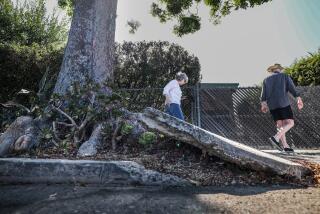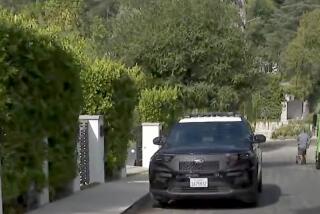Cul-de-Sacs Help Turn Around High Crime Areas : City streets: Drive-by shootings and drug trafficking are reduced when barriers are installed, police say.
- Share via
Los Angeles authorities may be in the process of disproving the political maxim of Philadelphia’s controversial former mayor, Frank Rizzo, who once noted that the streets in his city were safe; it was people who made them unsafe.
In recent experiments, police officials have built concrete barricades in crime-ridden Los Angeles neighborhoods, turning streets into cul-de-sacs. Changing the streets, it turns out, appears to reduce random crimes, drug transactions and drive-by shootings.
Police in the San Fernando Valley began closing off streets in neighborhoods several years ago. But now, police are trying to expand the concept through Operation Cul De Sac, which started on Feb. 1 in the Newton area downtown, considered a crime “hot spot.”
A top police official is impressed enough with the initial results that he envisions possibly restricting access to entire communities, thereby discouraging crime and making it easier for police to trap criminals.
The city has an architect drawing up plans to redesign what are now unattractive concrete barriers into more aesthetically pleasing, landscaped barricades that could be left in place permanently.
Although it is too early to know how successful the use of cul-de-sacs would be on a large scale, the results of experiments are promising, according to Robert Vernon, assistant chief and director of the Office of Operations.
“We may have accidentally stumbled on something,” he said. “We may need to re-engineer the city streets.”
The first experiment took place three years ago at Park Parthenia in the Devonshire District of the Valley, a drug-dealing center that came to be nicknamed “blood alley.”
Then last year, another barricade was placed at Willis Avenue and Blythe Street in Van Nuys, which meant anyone committing a crime on Blythe in the three-block stretch between Van Nuys Boulevard and Willis would have to turn around and go out the way they came in.
Sawhorse barricades have been erected temporarily in many areas around Los Angeles to cut down on narcotics traffic, but the street in the Van Nuys neighborhood has been completely sealed off by the blockades, which remain after a year.
Cars can drive around a sawhorse, but the barricade turns them back.
“The barricade has been more than 60% effective in cutting down narcotics traffic,” said Sgt. Harry Mauk.
Foot patrols were added after the barrier went up. But Mauk said the barricade has been successful even without the patrols. Drive-by shootings in the area have declined dramatically.
“I’m not saying we’ve stopped drive-by shootings, but we’ve stopped them there,” Mauk said. “You can’t do an effective drive-by shooting if you have to turn around and come back.”
Following that experience, according to Vernon, police have created two cul-de-sacs in a 30-square-block section of the Newton area near Jefferson High School as part of the six-month Operation Cul De Sac experiment, which includes foot patrols and small barriers on other streets in an ambitious attempt to expand the street-closing concept.
Newton is an ideal place to test the idea. In the 30-square-block area, there were 37 drive-by shootings and 112 violent assaults, and 100 murders in the overall area in 1989.
Vernon said the results in the Newton area have been promising. Two weeks into the program, drug czar William J. Bennett toured the area and praised the ambitious anti-crime effort. Since the program started, aggravated assaults have dropped 45% in the area. But because the program in the Newton district only started in February, the true reduction is probably even steeper, he said. There have been no drive-by shootings since the cul-de-sacs were built and the foot patrols began. There were five shootings in the same area during the same time period in 1989.
As many as 125 students have returned to Jefferson High School since the enforcement effort began because they feel safer, said Principal Philip Saldivar.
“Sgt. George Gascon, who coordinates the project, reports that two students, who out of fear had not gone to school for six months, returned to school,” according to a report on the operation released by Vernon.
“We have more spectators at athletic events” because people feel more comfortable, Saldivar said.
Saldivar said some of this is due to the presence of foot patrols. But he said the cul-de-sacs are also having an impact. Vernon said he is impressed enough with the cul-de-sac concept that he thinks the city ought to consider “making the whole neighborhood cul-de-sacs.”
He stressed that any decision would have to be made by the City Council and the community. But already, he said, other residents in the area and around the city have begun asking that their streets be blocked off.
If this method of crime control is practiced on a large scale, inner-city neighborhoods could some day look like suburban tracts, with winding, interior streets that go nowhere. It might be more frustrating for motorists, but it could be a boon to law enforcement, according to Vernon, because police would have an easier time trapping criminals.
There are budgetary considerations, however. The foot patrols in Newton used up $250,000 in overtime funds in the first two weeks. Erecting one permanent barricade in the Valley is costing about $7,000.
Bob Gay, an assistant to Councilman Gilbert Lindsay, whose district includes the Newton area, said the cul-de-sac operation has been successful and has added to the sense of community in the area.
“If we can get the support in the community to block off more streets, we would do that,” he said.
In the past, some residents have criticized the sawhorses that were erected to discourage drug trafficking, complaining that they looked too militaristic. In an effort to make the concept more palatable, Lindsay has asked an architect to design an attractive, landscaped barricade that could be permanently located in the area.
The Police Department expects to receive the drawings next week, and will send them to Lindsay.
“The more we can beautify and enhance the area the better,” Gay said.
More to Read
Sign up for Essential California
The most important California stories and recommendations in your inbox every morning.
You may occasionally receive promotional content from the Los Angeles Times.










